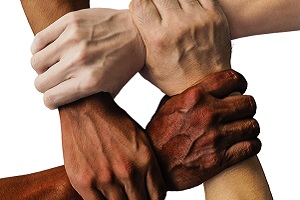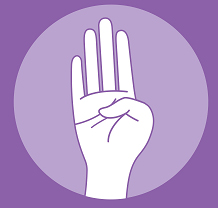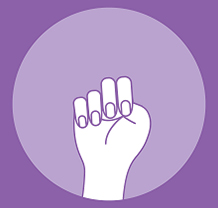
Safety and Privacy Alert: If you are viewing this, you may wish to maintain your privacy on the internet. Any use of the internet leaves a trail – this site is no different. Learn how to ensure your privacy. To close this web page quickly press Alt+F4 or Cmd+Q (Mac).
The City of Toronto has developed this web page as a resource for employees.

Test your knowledge of domestic/intimate partner violence by answering these true or false questions.
| Number | Question | True or False |
|---|---|---|
| 1. | Domestic/intimate partner abuse affects a small percentage of Canadians. | True or False |
| 2. | Domestic/intimate partner violence does not usually result in serious injury. | True or False |
| 3. | Violence between two men or two women in a same-sex relationship is a “fight” between equals. | True or False |
| 4. | Women with disabilities are at a heightened risk of abuse. | True or False |
| 5. | Abuse affects people from all socio-economic, cultural, religious and racial backgrounds. | True or False |
| 6. | People remain or return to violent relationships for safety reasons. | True or False |
| 7. | Men are abused by their partners as often as women. | True or False |
| 8. | People remain in abusive relationships because they don’t mind being abused. | True or False |
| 9. | If you fight back then it’s not abuse. | True or False |
| 10. | Women who experience abuse are at increased risk once they leave their partners. | True or False |
| 11. | Abuse, including violent attacks, is less frequent and less severe when a woman is pregnant. | True or False |
| 12. | There is greater equality and mutuality in lesbian/gay relationships and therefore partners are seldom abusive. | True or False |
| 13. | A person who beats or emotionally abuses their partner, but not their children, is still a good parent. | True or False |
| 14. | Transgender women are more likely to experience physical violence and discrimination within an intimate relationship. | True or False |
| 15. | Women are not violent. | True or False |
| 16. | Domestic violence primarily occurs among people who hang out at bars, have lower incomes or are people of colour. | True or False |
| 17. | The law does not and will not protect same-sex partners who experience domestic violence. | True or False |
| 18. | Abusive partners are more apt to seek or counter-sue for child custody. | True or False |
| 19. | 2SLGBTQ+ survivors of domestic violence are less likely to report incidents to the authorities or access shelters geared for survivors of domestic violence than cisgender and heterosexual survivors. | True or False |
| 20. | Upon leaving an abusive relationship, women are able to immediately restructure their lives. | True or False |
| 21. | On average, seven per cent of Ontario women living in a common-law or marital relationship are abused by their spousal partner. | True or False |
| 22. | Individuals who identify as being 2SLGBTQ+ do not experience domestic abuse. | True or False |
| 23. | People who experience domestic violence typically report to work normally without any recognizable absences. | True or False |
| 24. | Men in same-sex relationships are as likely to experience domestic abuse as heterosexual women. | True or False |
Sources:

Review the myths and facts of domestic/intimate partner violence.
Domestic/intimate partner abuse is a family matter.
Abusing, battering, assaulting or raping another person is a criminal offence. Domestic/intimate partner abuse has far-reaching social implications for everyone, affecting the abused person’s ability to lead a productive life and encouraging children brought up in an abusive home to repeat the cycle themselves and having a detrimental impact on their emotional and sometimes physical well-being. A lot of doctors and hospital time and funds are needed to help those who have been abused or beaten.
Abuse only happens in certain “problem” families, ethnic minorities, uneducated or poorer areas.
People from many different backgrounds are abused. Abuse cuts across race, class, gender identity, sexual orientation and cultural lines. People experiencing abuse have different levels of education and incomes, come from all age groups, races, and religions and have different levels of ability.
Lesbians, bisexual women, gay men, bisexual men and transgender men and women don’t get battered or abused.
Gender identity and sexual orientation doesn’t make any difference. Abuse is about control within a relationship and can occur within any relationship where one partner believes they have the right to control the other. Whether they are married or living together, of the same or opposite gender, have been together for a few weeks or many years really doesn’t make much difference – abuse can and does occur.
Domestic/intimate partner abuse is caused by excessive alcohol or the use of drugs.
A lot of research is going into the link between drug or alcohol use and violence. However, although some abusers are more prone to being violent when drunk, many more abuse when completely sober. Alcohol and drugs may increase the violence, but they do not cause it. Alcohol and drug abuse are separate issues from abuse, though they may overlap. Once again, blaming chemical dependency for abuse is missing the point; abusers are responsible for their actions.
Domestic/intimate partner abuse is a one-off incident.
Very rarely is abuse a one-off. Most often it is part of an ongoing means of establishing and maintaining control over another person. Abuse tends to increase both in velocity and extent over a period of time.
It can’t be that bad or she/he would leave.
There are many emotional, social, spiritual and financial hurdles to overcome before someone being abused can leave. Very often the constant undermining of the person’s self-belief and self-esteem can leave him/her with very little confidence, socially isolated and without the normal decision-making abilities. Leaving or trying to leave will also often increase the violence or abuse, and can put both the abused person and any children in a position of fearing for their lives. Leaving is the ultimate threat to the abusers power and control, and the abuser will often do anything rather than let the abused person go.
Abusers are always coarse, nasty, violent men and easily identified.
Abusers are often seemingly charming, generous and well-presented people who can hold positions of social standing. Abuse is kept for those nearest to them, in the privacy of their own homes. This Jekyll and Hyde tendency of the abuser can further confuse and frighten the person being abused, as the person in private is so very different to the person everyone else sees. It can also mean that when the person being abused finally does try to tell friends, family or acquaintances of the abuse, they are not believed because the person they are describing simply doesn’t fit the image portrayed in public.
Abusers just have a problem expressing anger. They need counselling or anger management courses to learn to resolve disputes without violence.
Most abusers have no problem resolving disputes with their boss or other outside person without resorting to violence. They chose to use violence and other forms of abuse against their partner as a means of maintaining their power over them.
The abused person provoked the violence.
The abuser is completely responsible for the abuse. No one can say or do anything that warrants being beaten and battered. Abusers often try to deflect their responsibility by blaming the partner via comments, such as:
“You made me angry.”
“You made me jealous.”
“This would never have happened if you hadn’t done that.”
“I didn’t mean to do that, but you were out of control.”
Those who are abused need to be assured that the abuse is not their fault.
Domestic/intimate partner abuse is a private matter and it’s none of my business.
We all have a responsibility to care for one another. Say something. If you don’t, your silence is the same as saying abuse is okay. Because you care, you need to do something… before it is too late.
The partners need couples counselling.
It is the abuser alone who needs counselling in order to change behaviour. Couples counselling is an inappropriate intervention that further endangers the abused person. It encourages the abuser to blame the other person by examining their ‘role’ in the problem. By seeing the couple together, the therapist erroneously suggests that the partner, too, is responsible for the abusers behaviour.
Violence between two men or two women in a same-sex relationship is a “fight” between equals.
Domestic/intimate partner violence is not the same as a consensual fight, no matter who is involved. Loving, healthy relationships do not include physical fighting. Domestic/intimate partner violence is about control and domination of one person by another; either person could be male, either person could be female. Abusers do not have to be bigger or stronger than the person they abuse.
When you leave your abusive relationship your risk decreases.
Once you leave, your partner’s abusive behaviour may continue for a while, or get worse. Separation (before, during and after) can be a time of high risk for someone leaving an abusive relationship. This is an important time to have a safety plan for you and your loved ones. You are strongly encouraged to speak to someone about safety planning and measures you can take to increase your safety. If you think you are at risk of being harmed by your partner, call police. Their role is to make sure that everyone is safe.
People remain in abusive relationships for a variety of reasons. Reasons people stay include:
Love
The person feels that the relationship is not all bad.
Hope
The person hopes that the relationship will improve.
Financial Concerns
The person is financially reliant on the abuser or does not have adequate funds to leave.
Children
The person is concerned about the well-being of his/her children.
Fear
There are threats to harm the person, the person’s children and/or the person’s family.
Source:

Anyone can experience domestic/intimate partner violence, regardless of age, race, religion, sexual orientation, economic status or educational background. The abuser may be a current or former spouse or intimate partner, relative or friend. Some people may not realize that what they are experiencing is domestic/intimate partner violence. Co-workers witnessing or hearing of such behaviour may also not understand this. This is in part due to the fact that the majority of violent workplace incidents are committed by someone the person knows.
Do you think one of your colleagues may be in an abusive relationship? Here are some workplace-specific warning signs and symptoms.
Someone who is abusive at home may be “invisible” as an abuser at work. While not all abusers reveal overtly violent behaviour, some visible warning signs that may indicate an abusive temperament include:
Sources:

Abuse can take many forms. It can be emotional, psychological, social, sexual, financial and/or physical. Sometimes a number of these kinds of abuse occur at the same time.
It is deliberate and purposeful violence, abuse and intimidation perpetrated by one person against another in an intimate partner relationship. It happens between two people when one person exercises power over the other person. It usually causes fear, physical and/or psychological harm. It may be a single act or a series of acts.
You may be experiencing abuse in your intimate partner relationship if:
If these examples sound familiar, you may be experiencing abuse.
Remember that abuse is never acceptable and physical and sexual abuse are crimes under Canadian law. If you have questions, reach out for support. Assistance and information is a phone call away.
Sources:

We have all experienced tension in our relationships. However, most relationships are not abusive. Domestic/intimate partner violence is not a disagreement or spat. It is a pattern of violence and abuse that occurs in intimate partner relationships. It is based on power and control. It is often about fear and intimidation.
“Am I afraid of my partner?”
No one deserves to be abused. The abuse is not your fault. If you have experienced abuse in your relationship, there are people who can help you. You can choose to make the decisions that are right for you. It takes a lot of courage and strength to face these issues. Help is available.
Source:

You must always be sensitive and respect the privacy of colleagues who may be experiencing domestic/intimate partner violence. There are ways you can be supportive of your co-worker, who may be in an emotionally or physically abusive relationship.
As a co-worker, you may recognize the warning signs. Your role is to be supportive and to focus on safety.
Opening a conversation with someone who you think might be experiencing domestic/intimate partner violence is an important first step.
Always remember that safety is the priority at all times. If there is a clear threat to the workplace or an incident of workplace domestic/intimate partner violence, you must tell the appropriate authorities, such as the police and workplace security.
Before approaching a person you suspect is being abused, learn about the policies and procedures in your workplace, as well as community resources that are available. Identify an appropriate person in management that the person could talk to if he/she chooses to disclose further.
You may instinctively believe that a colleague may be experiencing domestic violence. To assist you in determining whether you should approach your colleague, see the “How to Recognize Domestic/Intimate Partner Violence in the Workplace” page on this site.
If you decide to approach your colleague, be aware that there are certain things that are appropriate to say in these circumstances and certain things that should not be said.
Sources:
If you feel unsafe at home because of abuse, there is a way to let people know you need assistance. The Signal for Help is a new online initiative that has been launched to help people experiencing violence related to home isolation during COVID-19. It is a simple hand gesture that someone living with abuse can silently display during video calls to alert friends, family or colleagues that they need assistance and want someone to check in with them in a safe way.
Since the onset of COVID-19, countries around the world are reporting an increase in domestic/intimate partner violence. We know that staying at home with our loved ones can be stressful for many of us. For people living in abusive relationships, safety issues are heightened and being at home can be even more dangerous. Women, girls and trans and non-binary people are at an increased risk of intimate partner violence, emotional abuse and sexual violence during this pandemic due to many factors. These could include increased stress and isolation due to physical distancing, fewer financial resources, and abusers monitoring devices and restricting access to services and supportive people. There are also fewer available shelter and support services.
If you are teleworking and want to let people at work or in your personal life know you are concerned about your safety and need assistance, the following images and video from the Canadian Women’s Foundation shows you how you can use the Signal for Help on a video call.

1. Palm to camera and tuck thumb

2. Trap thumb
If you see someone using the Signal for Help when you are on a call, please find a way to check in with the person safely and find out what they need and how they want you to assist them. You can do this by calling them. Make sure you ask if they can talk and ask simple questions or ones that require a yes or no response to find out how you can help. You can also find out if there is a better way to contact them safely such as by text, email or social media.

Employee Assistance Program (EAP)
The City of Toronto’s EAP, provided by TELUS Health, offers confidential short-term counselling, information and referral services to members of the Toronto Public Service and eligible family members. Call 1-833-382-5610 or 437-880-7228 (for City landline) – 24/7.


Domestic/Intimate Partner Violence Resources
Many resources are available to provide guidance and support. This PDF file, available for download, provides a comprehensive list of resources. The City recognizes there are other forms of family violence and some of these resources may be helpful.
Domestic/Intimate Partner Violence Poster
To raise awareness of this issue, please print and post this in your workplace.